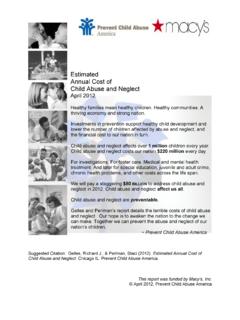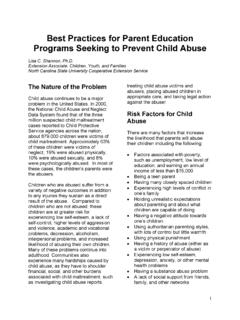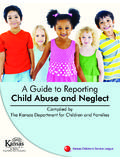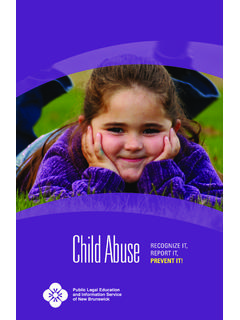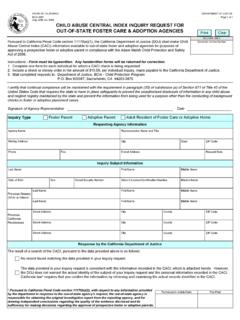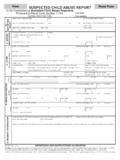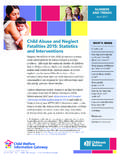Transcription of The Adverse Childhood Experiences Study: Child Abuse and ...
1 Making the Case: Why Prevention Matters Across the nation there has been great progress in work to improve the health and well-being of children. But the turbulent economy and the budget cutting that has come with it threaten to derail efforts to prevent Child Abuse and neglect at a moment when it is needed most. If the work that has done so much for children is to continue and to grow, it is important to show that it yields benefits on many levels for children, their families, and their communities. Consistent decisions to support the needs of children are at the heart of a bright future. The information offered in the Why Prevention Matters series will help those working so hard to improve the lives of our youngest Adverse Childhood Experiences study : Child Abuse and Public Health- Dr.
2 Robert AndaIn Brief: The Adverse Childhood Experiences (ACE) study assesses the effects of Child Abuse and related Adverse Childhood Experiences as a public health problem and the results clearly show Why Prevention Matters. The study is an ongoing collaboration between the Centers for Disease Control (CDC) and Kaiser Permanente. Begun in 1994, the study includes 17,337 adults enrolled in the Kaiser HMO in San Diego, CA. Fully two-thirds of the study participants reported at least one Adverse Childhood experience such as Abuse or neglect, with most reporting more than one. By bringing understanding of the Childhood origins of myriad health and social problems across the lifespan, this study shows that prevention of ACEs, such as Abuse and neglect, can have enormous impact on the health of our society.
3 The ACE Pyramid: A New Framework for PreventionDuring the 1980s and early 1990s information about risk factors for disease had become widely known. However, risk factors such as smoking, alcohol Abuse , and obesity for common diseases are not randomly distributed in the population. The ACE study was designed to answer the question: If risk factors for disease, disability, and early mortality are not randomly distributed, what early life influences precede the adoption or development of them? The ACE Pyramid (See Figure 1) depicts this conceptual framework. By taking a whole life perspective the ACE study began to progressively uncover how Childhood stressors (ACEs) affect health and social well-being throughout the are Common The study measured a variety of ACEs and many health and social problems.
4 This approach is the essence of public health investigations of factors that affect the health of a society. The first finding is that ACEs are common, even in a middle class HMO population! The 10 categories of ACEs and the prevalence of persons exposed to them during their first 18 years of life are shown in the first column of Insert are Highly Interrelated An Important Insight for PreventionMost people with one ACE also have others. Insert 1 also shows the percent of people who have other ACEs by category of experience . As a result, a new perspective for prevention of these Experiences has evolved. Namely, organizations have traditionally been aligned to address single types of ACEs.
5 Now, it is clear that organizations would benefit from a common goal that coordinates efforts to prevent a variety of on next South Wabash, 10th Floor | Chicago, IL 60604 | ph. | ACE Score Adding up the ImpactThe ACE Score takes interrelatedness of ACEs into account to show how they add up to exert their effects. The number of categories of ACEs is added up for each person to produce the ACE Score (range: 0-10). An ACE Score of 0 means that none of the categories were reported, while an ACE Score of 5 means that the person reported 5 categories of prevalence of ACE Scores in the study population is as follows: 0=33%, 1=26%, 2=16%, 3=10%, >4=15%.
6 The ACE Score Shows the Cumulative Biologic Effects of Childhood StressorsThe ACE Score captures the cumulative negative impact on social, emotional and cognitive development, and other impairments in the function of brain and body systems. These impairments are the biologic pathways to health risks, disability, disease, and early mortality. The short- and long-term outcomes of these Childhood exposures include many health and social problems. As the number of Adverse Childhood Experiences increases, the risk of developing significant health problems increases in a strong and graded fashion; this is called a dose-response reaction. More ACEs equals more risk for negative outcomes!
7 For example, because smoking is a leading cause of preventable health problems, it is important to understand the graded relationship of ACEs to early smoking initiation, current smoking as an adult, and chronic obstructive pulmonary disease a long term consequence of smoking. (See Figure 2) The health and social problems associated with the ACE Score read like a Who s Who of major public health priorities in the United States. Insert 2 shows a partial listing of health and social problems that have been documented to have a graded relationship to the ACE Reducing ACEs Will Greatly Improve Public HealthThe ACE study findings suggest that Adverse Childhood Experiences are major risk factors for the leading causes of illness, disability and death as well as poor quality of life in the United States.
8 Progress in preventing and recovering from the nation s worst health and social problems will benefit from the understanding that many of these problems arise as a consequence of Adverse Childhood are more than 50 peer-reviewed publications from the ACE study . A complete listing of the findings is available by subject at: video discussion of the ACE study is available at: the AuthorDr. Robert Anda is a Senior Researcher in Preventive Medicine and Epidemiology and a consultant to the Centers for Disease Control and Prevention. He is the Principal Investigator with the Adverse Childhood experience (ACE) study which is the largest-scale study ever done of the health and social effects of Adverse Childhood Experiences over the lifespan.
9 He spent 20 years in the Public Health Service at CDC conducting research in a variety of areas including disease surveillance, behavioral health, mental health and disease, cardiovascular disease investigations, and Childhood determinants of health, all topics in which he has written and published on next South Wabash, 10th Floor | Chicago, IL 60604 | ph. | with the Author on next South Wabash, 10th Floor | Chicago, IL 60604 | ph. | 1 ACE PyramidEarly DeathDeathConceptionDisease, Disability and Social ProblemsAdoption of Health-risk BehaviorsSocial, Emotional & Cognitive ImpairmentAdverse Childhood ExperiencesScientific GapsFigure 2 The ACE Score and SmokingEarly Smoking InitiationCurrent SmokingCOPDP ercent with Health Problem (%)20181614121086420(ACE Score) 0, 1, 2, 3, 4 or MoreInsert 1 ACE CategoryPrevalence (%)Additional ACEs (%)
10 Abuse0 1 2 3 4 Dysfunction Domestic Substance Mental Parental 2 Health Issues Associated with the ACE ScoreRisk FactorsAlcoholism and Alcohol Abuse Smoking Illicit Drug Use and IV Drug Abuse Obesity Suicide Attempts Depression, Anxiety, Hallucinations Teen and Unintended Pregnancies Spontaneous Abortion or Fetal Death Intimate Partner Violence Poor Quality of Life and Diseases and Early MortalityChronic Obstructive Pulmonary Disease (COPD) Ischemic Heart Disease (IHD) Liver Disease Sexually Transmitted Diseases (STDs) Lung Cancer Death Before Age 65 228 South Wabash, 10th Floor | Chicago, IL 60604 | ph.


